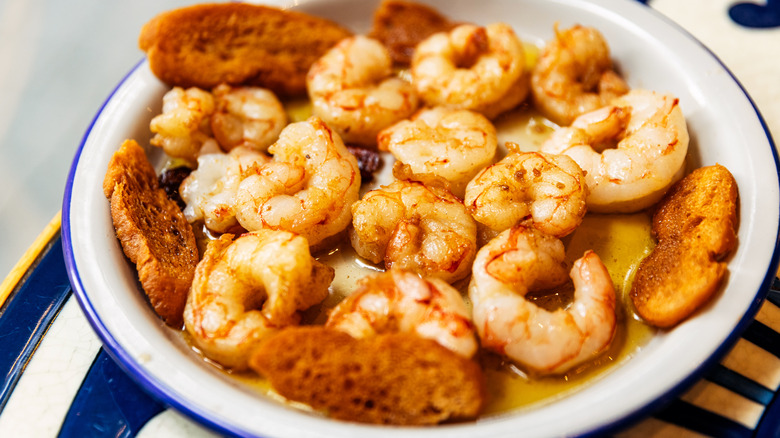Don't Expect Any BBQ Flavor If You're Eating Louisiana Barbecue Shrimp
Picture this: You're visiting New Orleans, excited to try some famous dishes, including one of the state's most iconic sandwiches, the po' boy. You decide to order a barbecue shrimp po' boy, only to find it has none of the sweet, smoky, tomato-and-molasses flavor we typically associate with barbecue sauce. Not only that, the shrimp isn't even grilled! Instead, it's sautéed, buttery, peppery, and has a pleasant kick. What gives? Turns out, in New Orleans and the greater Louisiana area, "barbecue shrimp" has nothing to do with throwing a shrimp on the barbie or coating it in Kansas City-style barbecue sauce. It's a dish all its own, with a proud history and absolutely addictive flavor.
The name does refer to the distinctive, buttery sauce that barbecue shrimp is cooked in, but it doesn't resemble any of the popular regional barbecue sauces we're used to. Instead of a tomato, vinegar, mustard, or mayonnaise base, New Orleans-style barbecue shrimp is made with a whole lot of butter, Worcestershire sauce, garlic, pepper, and Creole or Cajun seasoning. Many recipes also include hot sauce, lemon, rosemary, and even beer. Supposedly, the resulting shrimp-in-sauce has a reddish tint that reminded its early consumers of barbecue marks, hence the name. It's not exclusively served in po' boy sandwiches, either. Diners within New Orleans (and fans of the city's cuisine around the world) often eat the shrimp on their own with a side of crispy French bread.
How did Louisiana barbecue shrimp originate?
Though barbecue shrimp has become a staple of New Orleans cuisine, according to legend, locals actually have Chicago to thank for inspiring the dish (in a roundabout sort of way). Reportedly, it was invented by a chef at New Orleans' historic restaurant, Pascal's Manale, in 1953, after one of their regular customers returned from a business trip in Chicago and described a dish they had eaten that included shrimp, butter, and pepper. Based on that limited description, Chef Jake Radosta came up with the recipe for barbecue shrimp, and the rest was history.
Barbecue shrimp may be cooked in a variety of ways — sautéed, oven-baked, or even grilled — but it's most commonly sautéed. It appears Pascal Manale's recipe follows suit. When NPR interviewed the restaurant's chef, Mark DeFelice, in 2015, he revealed their recipe specifically calls for large, head-on shrimp "because it contains the fat and the protein, and that's where a lot of the flavor is from in the barbecue shrimp." If smaller, headless shrimp are all you have access to, however, it's still possible to make the dish: Just reduce your cooking time and up your seasoning game.

